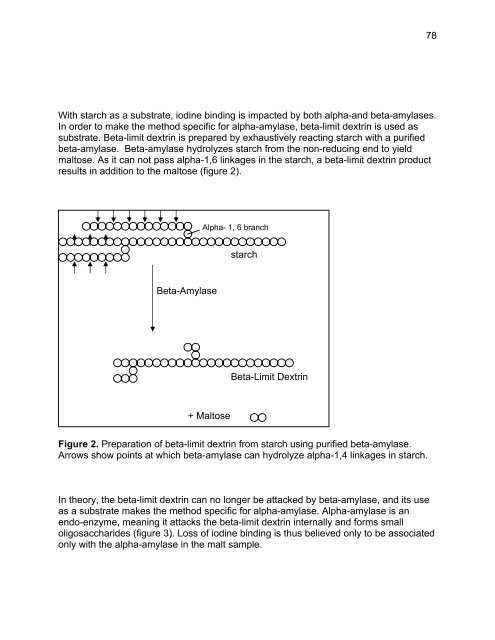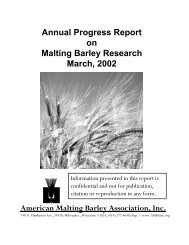Annual Progress Report on Malting Barley Research March, 2007
Annual Progress Report on Malting Barley Research March, 2007
Annual Progress Report on Malting Barley Research March, 2007
You also want an ePaper? Increase the reach of your titles
YUMPU automatically turns print PDFs into web optimized ePapers that Google loves.
With starch as a substrate, iodine binding is impacted by both alpha-and beta-amylases.<br />
In order to make the method specific for alpha-amylase, beta-limit dextrin is used as<br />
substrate. Beta-limit dextrin is prepared by exhaustively reacting starch with a purified<br />
beta-amylase. Beta-amylase hydrolyzes starch from the n<strong>on</strong>-reducing end to yield<br />
maltose. As it can not pass alpha-1,6 linkages in the starch, a beta-limit dextrin product<br />
results in additi<strong>on</strong> to the maltose (figure 2).<br />
Beta-Amylase<br />
Alpha- 1, 6 branch<br />
+ Maltose<br />
starch<br />
Beta-Limit Dextrin<br />
Figure 2. Preparati<strong>on</strong> of beta-limit dextrin from starch using purified beta-amylase.<br />
Arrows show points at which beta-amylase can hydrolyze alpha-1,4 linkages in starch.<br />
In theory, the beta-limit dextrin can no l<strong>on</strong>ger be attacked by beta-amylase, and its use<br />
as a substrate makes the method specific for alpha-amylase. Alpha-amylase is an<br />
endo-enzyme, meaning it attacks the beta-limit dextrin internally and forms small<br />
oligosaccharides (figure 3). Loss of iodine binding is thus believed <strong>on</strong>ly to be associated<br />
<strong>on</strong>ly with the alpha-amylase in the malt sample.<br />
78
















